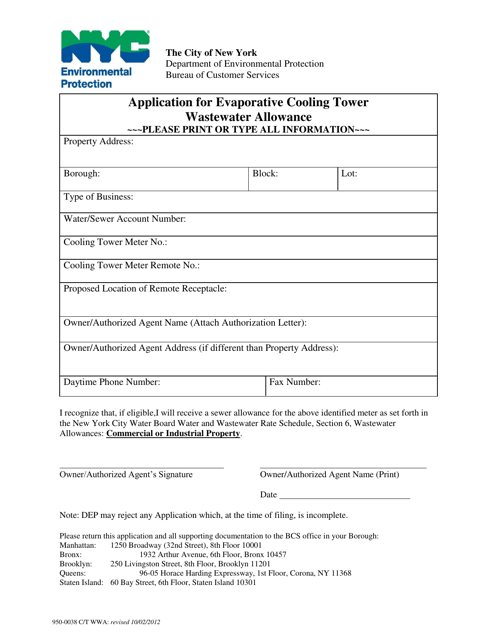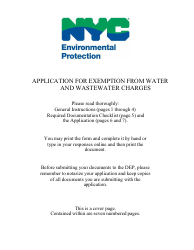Application for Evaporative Cooling Tower Wastewater Allowance - New York City
Application for Evaporative Cooling Tower Wastewater Allowance is a legal document that was released by the New York City Department of Environmental Protection - a government authority operating within New York City.
FAQ
Q: What is an evaporative cooling tower?
A: An evaporative cooling tower is a system used to cool water by evaporation.
Q: Why do evaporative cooling towers generate wastewater?
A: Evaporative cooling towers generate wastewater due to evaporation and drift loss.
Q: What is the purpose of an evaporative cooling tower wastewater allowance?
A: The purpose of an evaporative cooling tower wastewater allowance is to permit the discharge of the generated wastewater.
Q: Who needs to apply for an evaporative cooling tower wastewater allowance in New York City?
A: Anyone who operates an evaporative cooling tower in New York City needs to apply for the wastewater allowance.
Q: How can one apply for an evaporative cooling tower wastewater allowance in New York City?
A: To apply for an evaporative cooling tower wastewater allowance in New York City, one needs to submit an application to the appropriate authority.
Q: Are there any fees associated with the application for an evaporative cooling tower wastewater allowance in New York City?
A: Yes, there may be fees associated with the application for an evaporative cooling tower wastewater allowance in New York City.
Q: Is there a deadline for submitting the application for an evaporative cooling tower wastewater allowance in New York City?
A: Yes, there may be a deadline for submitting the application for an evaporative cooling tower wastewater allowance in New York City.
Q: What happens after the application for an evaporative cooling tower wastewater allowance is submitted in New York City?
A: After the application is submitted, it will be reviewed by the appropriate authority, and a decision will be made regarding the wastewater allowance.
Form Details:
- Released on October 2, 2012;
- The latest edition currently provided by the New York City Department of Environmental Protection;
- Ready to use and print;
- Easy to customize;
- Compatible with most PDF-viewing applications;
- Fill out the form in our online filing application.
Download a fillable version of the form by clicking the link below or browse more documents and templates provided by the New York City Department of Environmental Protection.




















